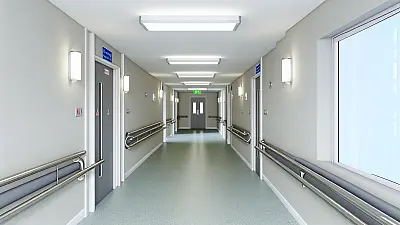HUMBLE, TX - A resident at Fall Creek Rehabilitation and Healthcare Center experienced a brain hemorrhage and required hospitalization after falling twice within 22 minutes, prompting state investigators to cite the facility for failing to provide adequate supervision and fall prevention measures.

Critical Fall Prevention Failures Lead to Serious Injury
According to a state inspection report dated February 5, 2025, the facility failed to implement proper safety measures for a resident who scored 26 out of 28 on the facility's fall risk assessment - indicating an extremely high likelihood of falling. Despite this severe risk score, the nursing home did not update the resident's care plan or provide adequate supervision to prevent multiple falls that resulted in serious injuries.
The inspection revealed a devastating sequence of events on January 11, 2025, when the resident fell at 2:17 PM with minor injuries, then fell again just 22 minutes later at 2:39 PM, sustaining serious injuries including a brain bleed and requiring stitches above the right eye. The resident was hospitalized and returned to the facility early the next morning at 3:33 AM, only to be transferred back to the hospital at 7:37 AM after another unwitnessed fall.
Understanding Fall Risk Assessment and Prevention Standards
Fall risk assessments use standardized scoring systems to evaluate a resident's likelihood of falling based on factors including mobility, medication effects, cognitive status, and previous fall history. Scores typically range from 0-28, with scores above 10 indicating significant fall risk requiring immediate interventions. A score of 26, as documented for this resident, represents an extreme fall risk that should trigger comprehensive safety measures.
Standard fall prevention protocols include enhanced supervision, environmental modifications, assistive devices, medication reviews, and individualized care plan updates. These interventions are designed to address specific risk factors and must be implemented immediately when high-risk scores are identified. The failure to update care plans after fall risk increases violates fundamental nursing home safety standards.
Medical research demonstrates that residents who fall once are at significantly higher risk for subsequent falls, particularly within the first 24-48 hours. Brain injuries from falls in elderly residents can lead to cognitive decline, increased mortality risk, and reduced quality of life. The rapid succession of falls described in this case represents a critical failure of the facility's safety systems.
Systemic Supervision and Documentation Deficiencies
The inspection identified broader systemic issues beyond the individual resident's case. State investigators found that the facility failed to maintain adequate supervision protocols for high-risk residents and did not properly implement preventive measures even after falls occurred. The documentation shows a pattern of reactive rather than proactive care management.
Proper nursing home protocols require immediate care plan revisions following any fall, with enhanced monitoring and specific interventions tailored to prevent recurrence. The facility should have implemented measures such as increased observation intervals, environmental safety modifications, and potentially one-on-one supervision for a resident with such an extreme fall risk score.
The unwitnessed nature of the final fall raises additional concerns about supervision adequacy. High-risk residents typically require visual checks every 15-30 minutes, and some may need constant supervision depending on their specific risk factors and cognitive status.
Industry Standards and Regulatory Requirements
Federal nursing home regulations require facilities to ensure residents receive care and services to attain or maintain their highest practicable physical, mental, and psychosocial well-being. This includes implementing comprehensive fall prevention programs that identify at-risk residents and provide appropriate interventions.
Evidence-based fall prevention strategies include environmental assessments, staff education, resident and family education, exercise programs, medication management, and assistive technology. The effectiveness of these programs depends on timely implementation and regular reassessment of interventions based on changing resident conditions.
Falls represent one of the most common preventable injuries in nursing homes, affecting approximately 1.5 falls per nursing home bed annually according to federal data. Research shows that structured fall prevention programs can reduce fall rates by 20-30% when properly implemented with adequate staff training and consistent monitoring.
Additional Issues Identified
The inspection documented the facility's immediate response measures, including completion of required incident reports to state health authorities and implementation of corrective actions. The facility initiated staff training on fall prevention protocols, comprehensive care plan requirements, and established a "Falling Star Program" using visual indicators to alert staff of residents at high fall risk.
Additional interventions included auditing all high-risk residents' care plans, conducting specialized training for licensed nursing staff on fall risk assessment interpretation, and implementing enhanced reporting procedures for all resident falls to ensure immediate administrative review and intervention.
The facility also initiated reviews of residents who experienced falls in the preceding 16 days, examining six residents with eight documented falls to ensure appropriate preventive measures were in place and care plans adequately addressed individual risk factors.
Full Inspection Report
The details above represent a summary of key findings. View the complete inspection report for Fall Creek Rehabilitation and Healthcare Center from 2025-02-05 including all violations, facility responses, and corrective action plans.
💬 Join the Discussion
Comments are moderated. Please keep discussions respectful and relevant to nursing home care quality.